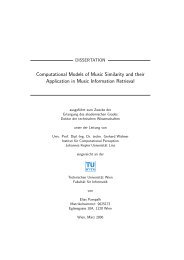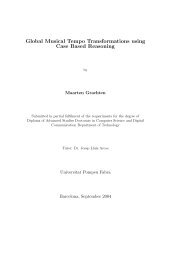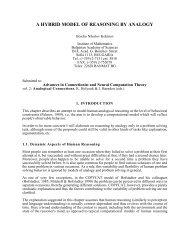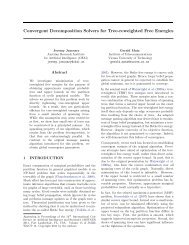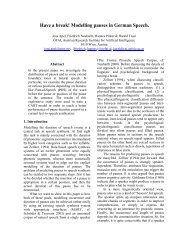First Suggestions for an Emotion Annotation and ... - OFAI
First Suggestions for an Emotion Annotation and ... - OFAI
First Suggestions for an Emotion Annotation and ... - OFAI
You also want an ePaper? Increase the reach of your titles
YUMPU automatically turns print PDFs into web optimized ePapers that Google loves.
MAPPING EMOTION REPRESENTATIONS<br />
The reason why EARL previews the use of different emotion<br />
representations is that no preferred representation has<br />
yet emerged <strong>for</strong> all types of use. Instead, the most profitable<br />
representation to use depends on the application. Still, it<br />
may be necessary to convert between different emotion<br />
representations, e.g. to enable components in a multi-modal<br />
generation system to work together even though they use<br />
different emotion representations [8].<br />
For that reason, EARL will be complemented with a<br />
mech<strong>an</strong>ism <strong>for</strong> mapping between emotion representations.<br />
From a scientific point of view, it will not always be possible<br />
to define such mappings. For example, the mapping<br />
between categories <strong>an</strong>d dimensions will only work in one<br />
direction. <strong>Emotion</strong> categories, understood as short labels <strong>for</strong><br />
complex states, c<strong>an</strong> be located on emotion dimensions representing<br />
core properties; but a position in emotion dimension<br />
space is ambiguous with respect to m<strong>an</strong>y of the specific<br />
properties of emotion categories, <strong>an</strong>d c<strong>an</strong> thus only be<br />
mapped to generic super-categories. Guidelines <strong>for</strong> defining<br />
scientifically me<strong>an</strong>ingful mappings will be provided.<br />
OUTLOOK<br />
We have presented the expressive power of the EARL<br />
specification as it is currently conceived. Some specifications<br />
are still suboptimal, such as the representation of the<br />
start <strong>an</strong>d end times, or the fact that regulation types c<strong>an</strong>not<br />
be associated a numerical degree (e.g., degree of simulation).<br />
Other aspects may be missing but will be required by<br />
users, such as the <strong>an</strong>notation of the object of <strong>an</strong> emotion or<br />
the situational context. The current design choices c<strong>an</strong> be<br />
questioned, e.g. more clarity could be gained by replacing<br />
the current flat list of attributes <strong>for</strong> categories, dimensions<br />
<strong>an</strong>d appraisals with a substructure of elements. On the other<br />
h<strong>an</strong>d, this would increase the <strong>an</strong>notation overhead, especially<br />
<strong>for</strong> simple <strong>an</strong>notations, which in practice may be the<br />
most frequently used. An iterative procedure of comment<br />
<strong>an</strong>d improvement is needed be<strong>for</strong>e this l<strong>an</strong>guage is likely to<br />
stabilise into a <strong>for</strong>m suitable <strong>for</strong> a broad r<strong>an</strong>ge of applications.<br />
The suggestions outlined in this paper have been elaborated<br />
in a detailed specification, currently submitted <strong>for</strong> comment<br />
within HUMAINE. Release of a first public draft is previewed<br />
<strong>for</strong> June 2006. We are investigating opportunities<br />
<strong>for</strong> promoting the st<strong>an</strong>dardisation of the EARL as a recommended<br />
representation <strong>for</strong>mat <strong>for</strong> emotional states in technological<br />
applications.<br />
ACKNOWLEDGMENTS<br />
We gratefully acknowledge the numerous constructive<br />
comments we received from HUMAINE particip<strong>an</strong>ts.<br />
Without them, this work would not have been possible.<br />
This research was supported by the EU Network of Excellence<br />
HUMAINE (IST 507422) <strong>an</strong>d by the Austri<strong>an</strong> Funds<br />
<strong>for</strong> Research <strong>an</strong>d Technology Promotion <strong>for</strong> Industry (FFF<br />
808818/2970 KA/SA). <strong>OFAI</strong> is supported by the Austri<strong>an</strong><br />
Federal Ministry <strong>for</strong> Education, Science <strong>an</strong>d Culture <strong>an</strong>d by<br />
the Austri<strong>an</strong> Federal Ministry <strong>for</strong> Tr<strong>an</strong>sport, Innovation <strong>an</strong>d<br />
Technology.<br />
This publication reflects only the authors' views. The Europe<strong>an</strong><br />
Union is not liable <strong>for</strong> <strong>an</strong>y use that may be made of<br />
the in<strong>for</strong>mation contained herein.<br />
REFERENCES<br />
1. Scherer, K. et al., 2005. Proposal <strong>for</strong> exemplars <strong>an</strong>d<br />
work towards them: Theory of emotions. HUMAINE<br />
deliverable D3e, http://emotion-research.net/deliverables<br />
2. Ekm<strong>an</strong>, P. (1999). Basic emotions. In Tim Dalgleish <strong>an</strong>d<br />
Mick J. Power (Ed.), H<strong>an</strong>dbook of Cognition & <strong>Emotion</strong><br />
(pp. 301–320). New York: John Wiley.<br />
3. Douglas-Cowie, E., L. Devillers, J-C. Martin, R. Cowie,<br />
S. Savvidou, S. Abrili<strong>an</strong>, <strong>an</strong>d C. Cox (2005). Multimodal<br />
Databases of Everyday <strong>Emotion</strong>: Facing up to Complexity.<br />
In Proc. InterSpeech, Lisbon, September 2005.<br />
4. Steidl, S., Levit, M., Batliner, A., Nöth, E., & Niem<strong>an</strong>n,<br />
H. (2005). "Of all things the measure is m<strong>an</strong>" - automatic<br />
classification of emotions <strong>an</strong>d inter-labeler consistency.<br />
ICASSP 2005, International Conference on<br />
Acoustics, Speech, <strong>an</strong>d Signal Processing, March 19-23,<br />
2005, Philadelphia, U.S.A., Proceedings (pp. 317--320).<br />
5. Scherer, K.R. (2000). Psychological models of emotion.<br />
In J. C. Borod (Ed.), The Neuropsychology of <strong>Emotion</strong><br />
(pp. 137–162). New York: Ox<strong>for</strong>d University Press.<br />
6. Cowie, R., Douglas-Cowie, E., Savvidou, S., McMahon,<br />
E., Sawey, M., & Schröder, M. (2000). 'FEELTRACE':<br />
An instrument <strong>for</strong> recording perceived emotion in real<br />
time, ISCA Workshop on Speech <strong>an</strong>d <strong>Emotion</strong>, Northern<br />
Irel<strong>an</strong>d , p. 19-24.<br />
7. Ellsworth, P.C., & Scherer, K. (2003). Appraisal processes<br />
in emotion. In Davidson R.J. et al. (Ed.), H<strong>an</strong>dbook<br />
of Affective Sciences (pp. 572-595). Ox<strong>for</strong>d New<br />
York: Ox<strong>for</strong>d University Press.<br />
8. Krenn, B., Pirker, H., Grice, M., Piwek, P., Deemter,<br />
K.v., Schröder, M., Klesen, M., & Gstrein, E. (2002).<br />
Generation of multimodal dialogue <strong>for</strong> net environments.<br />
Proceedings of Konvens. Saarbrücken, Germ<strong>an</strong>y.<br />
9. Aylett, R.S. (2004) Agents <strong>an</strong>d affect: why embodied<br />
agents need affective systems Invited paper, 3rd Hellenic<br />
Conference on AI, Samos, May 2004 Springer<br />
Verlag LNAI 3025 pp496-504<br />
10.de Carolis, B., C. Pelachaud, I. Poggi, M. Steedm<strong>an</strong><br />
(2004).APML, a Mark-up L<strong>an</strong>guage <strong>for</strong> Believable Behavior<br />
Generation, in H. Prendinger, Ed, Life-like Characters.<br />
Tools, Affective Functions <strong>an</strong>d Applications,<br />
Springer.<br />
11.Kipp, M. (2004). Gesture Generation by Imitation -<br />
From Hum<strong>an</strong> Behavior to Computer Character Animation.<br />
Boca Raton, Florida: Dissertation.com.




